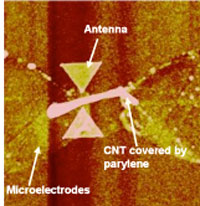| Posted: Apr 22, 2009 | |
Nanoantenna boosters for carbon nanotube infrared detectors |
|
| (Nanowerk Spotlight) Infrared (IR) detectors are used in imaging applications that include for instance medical diagnosis, environmental monitoring, space science, and security and military sensor devices. High-quality detectors require cryogenic cooling in order for the image not to be distorted by the detectors own radiation. This makes them expensive both to produce and to run. Although uncooled IR detectors are made, their resolution and image quality tend to be much lower than cooled detectors. | |
| It appears that carbon nanotubes (CNTs) could be used as novel IR detector material that would allow the fabrication of highly efficient detectors that do not require cooling. Researchers at Michigan State University have now, for the first time, experimentally demonstrated the design, manufacturing and experimental testing of an integrated nanoantenna concept for CNT based IR sensors. | |
| "As a one-dimensional nanostructural material, we have found that carbon nanotubes are very promising candidates for photovoltaics," Ning Xi tells Nanowerk. "Their unique properties, such as wide range of bandgaps and low thermal noise are important to the development of a range of novel functional infrared devices and systems. We have recently achieved a high efficient and fidelity CNT based IR detector by exploiting field localization using nano-antennas." | |
 |
|
| Schematic structure of a CNT based IR detector with a nanoscale antenna. (Image: Dr. Ning Xi, Michigan State University) | |
| Xi, John D. Ryder Professor of Electrical and Computer Engineering in the Department of Electrical and Computer Engineering at Michigan State University (MSU), together with members of his team, has presented the first experimental realization of a novel CNT based IR detector with a nanoantenna. | |
| Although nanoscale antennas have been investigated theoretically before, a practical sensitive IR device combined with nanoantenna-like structures has been firstly proposed and experimentally demonstrated now by Xi's team. | |
| "The photocurrent response of CNT sensors has been relatively low because of the small sensing area and low electric field" says Xi. "Our demonstration of the nano-antenna provides a solution to this problem. By incorporating the nano-antenna with the device, the electric field at the sensing area in a specific range of IR radiation can be increased." | |
| The MSU scientists have reported their findings, first authored by Carmen Kar Man Fung, in the April 14, 2009 online edition of Nanotechnology ("Nanoresonant signal boosters for carbon nanotube based infrared detectors"). | |
 |
|
| Atomic force microscopy image of the fabricated CNT based IR detector with bowtie nanoantenna. (Image: Dr. Ning Xi, Michigan State University) | |
| The development of these novel IR detectors – operating in ambient temperature – will allow significant simplifications and improvement of thermal imaging systems and will open up many applications that are currently limited due to cooling requirements and low sensitivity. | |
| According to Xi, the results of this research effort will broadly impact mainly on nanophotonics and nanomanufacturing and will help create a new multidisciplinary direction in nanotechnology and electromagnetics research. "It can provide new sensors and instruments for near-IR and middle-wave IR – leading to the development of new sensing technology for medical diagnostics, environment monitoring, and homeland security that are portable and efficient at room temperatures," he says. | |
 By
Michael
Berger
– Michael is author of three books by the Royal Society of Chemistry:
Nano-Society: Pushing the Boundaries of Technology,
Nanotechnology: The Future is Tiny, and
Nanoengineering: The Skills and Tools Making Technology Invisible
Copyright ©
Nanowerk LLC
By
Michael
Berger
– Michael is author of three books by the Royal Society of Chemistry:
Nano-Society: Pushing the Boundaries of Technology,
Nanotechnology: The Future is Tiny, and
Nanoengineering: The Skills and Tools Making Technology Invisible
Copyright ©
Nanowerk LLC
|
|
|
Become a Spotlight guest author! Join our large and growing group of guest contributors. Have you just published a scientific paper or have other exciting developments to share with the nanotechnology community? Here is how to publish on nanowerk.com. |
|
